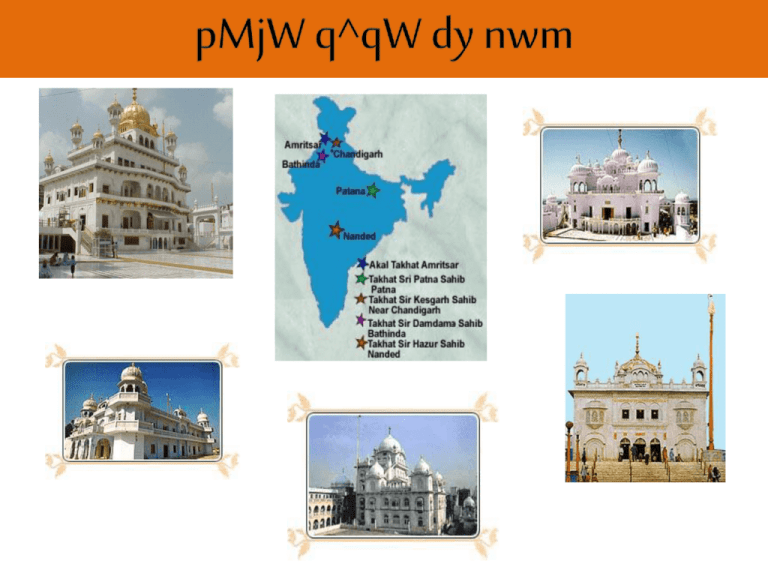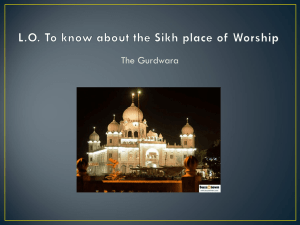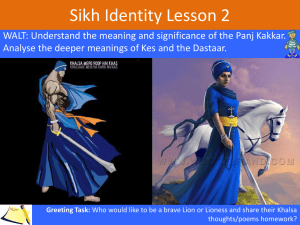Takht Sri Kesgarh Sahib Jee
advertisement

q^q sRI Akwl q^q swihb jI sRI
AMimRqsr swihb (pMjwb) [
q^q sRI hirmMdr jI, ptnw
swihb (ibhwr) [
q^q sRI kysgVH swihb jI sRI
An{dpur
swihb ijlHw ropV (pMjwb) [
q^q sRI dmdmw swihb jI, gurU
kI kWSI,
swbo kI qlvμfI, ijlHw biTμfw
(pMjwb) [
q^q scKMf sRI hzUr swihb jI,
nWdyV
(mhWrwStr) [
The first and foremost Takht is the Sri Akaal Takht Sahib Jee.
The literal meaning of Takht is ‘throne which is sat on by an emperor.’
Akaal means Timeless. We often refer to Vaheguroo (God) as The Timeless One as He is not bound by time. Vaheguroo has always
been here, is here with us now and will always be here.
After the shaheedi of Sri Guroo Arjan Dev Jee (the fifth Guroo of the Sikhs), Sri Guroo Hargobind Sahib Jee (the sixth Guroo of the
Sikhs) built the Akaal Takht Sahib with Bhai Gurdas Jee and Baba Buddha Jee. Guroo Jee named the Takht after God and not
after himself, his father or even after Sri Guroo Naanak Dev Jee.
Sri Guroo Hargobind Sahib Jee said that whoever comes in to the fold/organisation/protection of the Miri Piri (temporal and spiritual
power) will be saved. Sri Guroo Hargobind Sahib Jee said it is now time to turn to the sword. The two kirpaans of miri and piri
where placed on Sri Guroo Hargobind Sahib Jee by Baba Buddha Jee.
Guroo Jee also installed two Nishaan Sahibs near Sri Akaal Takht Sahib. The one closest to the Takht is lower than the one that is
closer to Sri Harmandir Sahib Jee. This signifies that a Sikh must be a saint (piri) first and then a soldier (miri).
Guroo Saahib would spend their evenings at Sri Akaal Takht Sahib. Here, they would see the bravery/strength of their Sikhs. Two
dhadhi’s by the names of Bhai Abdula Jee and Bhai Natha Jee (from Sursingh) would sing tales about brave warriors in
battle. Over a period of two months they sang all twenty four vaars from Sri Guroo Granth Saahib Jee Maharaaj.
The Akaal Takht Sahib is the highest political institute of the Sikhs. Sikhs would be invited to attend from far and wide. Under the
guidance of Dhan Sri Guroo Granth Sahib Jee Maharaaj the final decision would be read out by the Jathedhar and this would
be accepted by the Khalsa Panth. This continues even today. At the times of Sri Guroo Hargobind Sahib Jee Sarbat Khalsa
would take place twice a year (at Diwali and Vaisakhi).
The last Sarbat Khalsa was called in 1986 by the Panth, in which it was agreed that the struggle for an independent Sikh state will
continue until victory is achieved.
Patna Sahib, Bihar
In the year 1504, Sri Guroo Naanak Dev Jee went to Patna Sahib with Bhai Mardana Jee. When Guroo Jee was leaving the town he told a
merchant called Salis Rai that he would return in his tenth form.
Sri Guroo Gobind Singh Jee was born in the city called Patna. As a mark of respect we add Saahib to the end – Patna Saahib.
The second takht is called Sri Harmandir Jee.
Sri Guroo Gobind Singh Jee was called Gobind Rai before he was blessed with Amrit from the panj pyaarae.
Bhikan Shah was a well known Muslim saint. He was very loyal and honest. One day he did something he had never done before. He started
bowing in the opposite direction of Mecca during his prayers. This had never been done before. People thought that he had gone crazy.
When he was asked why he did this Bhikan Shah said, “If you could see who has come to take care of everything then you would bow in this
direction too.” He was talking about the coming of Sri Guroo Gobind Singh Jee.
Bhikan Shah went to Patna Saahib to see the child. He found out that a child had been born to Sri Guroo Tegh Bahaadur Jee, the ninth Guroo of
the Sikhs. The child’s name was Gobind Rai.
Bhikan Shah and Gobind Rai seemed to recognise each other straight away. Bhikan Shah had two pots which he placed in front of Gobind Rai.
With his playful spirit, he reached out with both hands and put one on each pot. Bhikan Shah became very happy.
Bhikan Shah explained that one of the pots represented the Muslim faith and the other represented the Hindu faith. Gobind Rai placed his hands
on both pots meaning he would look after all people and all religions.
Sri Guroo Gobind Singh Jee defended all people and he set up the army of the Khalsa that will always stand up for truth.
In 1666 when Guru Gobind Singh Ji was born – his father the 9th Guru of the Sikhs , Guru Tegh Bahadur Ji Maharaaj bought
some land & called the place Anandpur Sahib.
In Anandpur Sahib Guru Gobind Singh Ji built six forts to protect the city of Anandpur, Sri Kesgarh Sahib Ji is one of these six
forts.
Sri Kesgarh Sahib Ji is also the 3rd Takht of the Sikhs & is located in the centre of Anandpur Sahib.
It is at Sri Kesgarh Sahib Ji that the Vaisakhi of 1699 took place & it is the birthplace of the Khalsa.
The Panj Pyaarae, Guru Gobind Singh Ji, Guru Ji’s whole family & millions of Sikhs took Amrit at Sri Kesgarh Sahib Ji on the
day of Vaisakhi in 1699.
At Sri Kesgarh Sahib Ji today there are shasters belonging to Guru Gobind Singh Ji - these inculde;
•
•
The Khanda used in the Amrit Sanchar of 1699
•
Guru Gobind Singh Ji’s Kataar
•
Guru Gobind Singh Ji’s Saif (double edged weapon)
•
Guru Gobind Singh Ji’s gun
•
Guru Gobind Singh Ji’s spear (known as Karpa Barchha)
A Naagni – a twisted spear like the one Bhai Bachitter Singh Ji used to defeat an elephant.
Guru Kee Kashi, Sabo Kee Talwandi, Batinda, Panjab
Takht Sri Damdama Sahib, Guru Kee Kanshi, Sabo Kee Talwandi, Batinda, is one of the five seats of authority for Sikhs. This Takht is situated
at Batinda in Punjab, in a village called Sabo Kee Talwandi.
Damdama means a place to have a break and rest.
Sri Guru Gobind Singh Jee stayed here after fighting battles against the mughals. Before his arrival at Sabo Kee Talwandi, two of the Guru’s sons
were bricked alive at Sarhind and two laid down their lives at Chamkaur Sahib. After writing the Zafarnama, Sri Guru Gobind Singh
Jee fought a successful battle at Muktsar and then moved towards Sabo Kee Talwandi.
The true and complete form of Sri Guru Granth Saahib Jee was written at Sri Damdama Sahib by the hand of the great Sikh, Shaheed Bhai Mani
Singh Jee as Sri Guru Gobind Singh Jee recited gurbani off by heart. Sri Guru Gobind Singh Jee added to the original version prepared by Sri
Guru Arjan Dev Jee and the verses (hymns/shabads) of Sri Guru Tegh Bahadur Jee.
Baba Deep Singh Jee with firm faith would complete the seva of providing the paper, pens and ink. He also wrote four more saroops of Sri Guru
Granth Sahib Jee by hand and these can be found at the other four Takhts. Later, Shaheed Baba Deep Singh Jee was made the jathedhar of
the Takht by Guru Jee.
Within nine months and nine days the correct pronunciation and understanding of gurbani was taught to forty eight Singhs by Sri Guru Gobind
Singh Jee.
Guru Jee blessed Sabo Kee Talwandi, as Guru Ki Kanshi. Kanshi means holy shrine or centre of religious and spiritual learning and development.
He said that it would be a place where there would be many scholars, philosophers, writers, students and devotees of the Sikh Faith.
We should all strive to do as much seva as we can and use the skills, talents and qualities that we have to increase awareness of the Sikh faith.
Sachkand: Realm of Truth
Hazoor: Presence of the Master
After compiling Sri Guru Granth Sahib Jee at Damdama Sahib, Sri Guru Gobind Singh Jee travelled to the city he named Abchalnagar meaning
‘steadfast city’, to the sacred place now known as Takht Sachkhand Sri Hazoor Sahib Jee.
Takht Sachkhand Sri Hazoor Sahib is one of the five seats of authority for Sikhs. This Takht has a rich history of important events which all Sikhs
should remember.
It was at Sri Hazoor Sahib that Madho Daas met Sri Guru Gobind Singh Jee and was blessed with the gift of Amrit. Madho Daas was bestowed
with the new name Banda Singh Bahadur, meaning slave of the Guru. Guru Jee sent Baba Banda Singh Bahadur with five arrows and five
Singhs to fight Wazir Khan and his men in Sirhand. Baba Banda Singh Bahadur is respected as one of the greatest Sikh warriors and martyrs.
Bhai Daya Singh Jee and Bhai Dharam Singh Jee, two of the beloved Panj Piare took their last breath at Sri Hazoor Sahib.
Sri Hazoor Sahib Jee is where Sri Guru Gobind Singh Jee blessed the Sikhs with Sri Guru Granth Sahib Jee as the Living Guru- the Jagdi Jyot (the
divine light of all ten Guru Sahibs).
Sri Guru Gobind Singh Jee in the presence of five Singhs, placed a shaster, flowers, a coconut and five paise in front of Sri Guru Granth Sahib Jee
Maharaaj. Sri Guru Gobind Singh Jee bowed with devotion and did parkarma around Guru Granth Sahib Jee. He passionately informed the
Sikhs;
Sabh Sikhan Ko Hukam Hai Guru Maneo Granth
To all Sikhs, let this be the order, recognize the Granth as your Guru.
Sri Guru Gobind Singh Jee left their physical body in Hazoor Sahib. Sri Hazoor Sahib should be visited by all Sikhs so we can be blessed with the
darshan of Angetha Sahib (where Sri Guru Gobind Singh Jee is cremated) and Guru Jee’s holy weapons.
Sri Guru Granth Sahib Jee Maharaj should be treated with the utmost love, respect and devotion. Sri Guru Gobind Singh Jee emphasises the
power of Shabad Guru:
“Whatever you desire can be obtained by meditating on the Shabad (Verses) of Sri Guru Granth Sahib Jee.”






